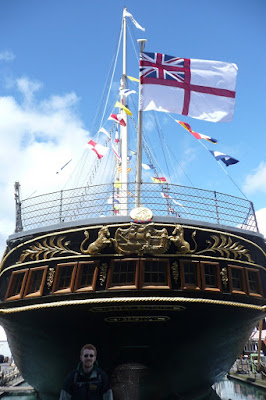
On our way back to Exeter following our trip home for Will’s Grandmommy’s funeral, we got to see the S.S. Great Britain from a distance, but today we finally got to visit it up close. We travelled to Bristol this morning primarily with that in mind, though we were fortunately able to see several of the city’s other sites as well.
Our day out began around 8:30 this morning. We had a bit of a scare when we were unable to retrieve our pre-booked (and paid for!) train tickets from the station’s ticket machines; however, one of the station’s employees in the travel center was able to print them out for us quickly, saving us from missing our train. The train ride was fairly uneventful, and we arrived in Bristol on time. Following the pedestrian route signs, we made our way to the harbourside and to the Great Britain. Using a 2-for-1 promotional offer from First Great Western, we were both able to enter for only £8.50. The museum well worth the cost, and we are allowed to visit as many times as we want within the next year.
We were able to walk around the dry-docked base of the ship and learn about the conservation methods being utilized to preserve it, including a pair of massive dehumidifiers called “Deep Thought I” (located inside the ship) and “Deep Thought II” (located in the drydock, which we were actually able to see). Then, we walked through some excellent exhibits outlining a major stages of the ship’s working history, including its roles in both world wars (admittedly as a source of spare parts in the second, as the ship was scuttled in 1937) and its life as the “first great ocean liner” in the middle 19th century. There were numerous hands-on activities within the exhibits, such as one that allowed visitors to learn about steering the ship.
Following the exhibits was the opportunity to go on board the ship, which is outfitted as it was in its days as an ocean liner making frequent voyages to Austrialia. We climbed the stairs onto the deck where we were asked to pick out one of the four types of free audio guides. There was a guide specifically for children (narrated by Sinbad, the ship’s cat) in addition to guides focused on maritime archaeology, the experience of first class passengers on board, and the experiences of steerage passengers on board. We both choose the first class guide. Interestingly, the commentary on the guide consisted entirely of excerpts from journals of real first class passengers describing different parts of the ship and aspects of life on board. There were a number of areas marked “First Class Passengers Only Beyond This Point;” no word on what the steerage audio guide does if you go beyond those points. Perhaps we will find that out on the next visit . . .
The museum uses smells and sounds, in addition to sights, to make the experience more realistic than many similar ones are. The lavatories area has a slightly unpleasant odor (and one door is slightly ajar, with a recording of “Can’t you see this lavatory is occupied?” which plays if you push on the door) and the area where horses were stored has a musty animal smell. Similarly, a museum employee plays some of the popular tunes of the time from the piano in the first class saloon (which in American English we would likely call a lounge). Though some of the efforts are rather cheesy, they make visiting the Great Britain an enjoyable experience for children and adults alike.
We ate lunch in the museum’s café. Will ordered a panini, and I ordered the soup of the day, which turned out to be an onion soup. We actually shared both items, since the panini was far more filling than the extremely tasty soup.
Following lunch, we visited Explore@Bristol, the city’s science museum. We had a 2-for-1 offer on admission to it, and our museum tickets included a 25 minute planetarium presentation. The museum was in many ways similar to Mobile’s Exploreum and Birmingham’s McWane Science Center, with numerous hands-on on science activities. One of our favorites was a water wheel powered by an apparatus which was labeled a “treadmill.” The treadmill was actually essentially a giant wheel like those that are put in hamster cages- except that this one was for people.
The planetarium presentation was nice, though confusing. Apparently, in the UK, the Big Dipper is called the plowman or the saucepan. It and the north star were the only mentioned stars and constellations that we had heard of before, because of the differences in what is visible in the night skies of Britain and Alabama.
When the museum closed at 6pm, we walked over to take pictures of Bristol’s cathedral. Taking pictures inside is prohibited, but we got several lovely shots of the exterior. The cathedral is magnificent, but it is nothing special when compared to some of the other British churches we have seen.
We also took pictures of the council house, which is located across from the cathedral. It, too, is an impressive structure. On our way back to the train station, we also got a look at the Christmas steps, a bombed-out church, and the Hippodrome.
At Will's request, we ate dinner at a local Subway and killed some time there before finally returning to the station to await our late-night train home. It would have been nice to have taken a slightly earlier train, but we'd booked this one accidentally, and changing the reservation would have been expensive.











No comments:
Post a Comment